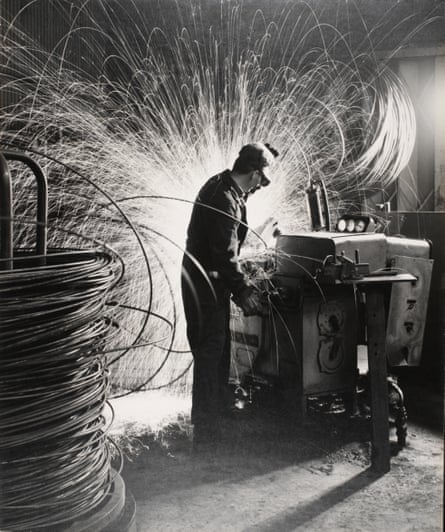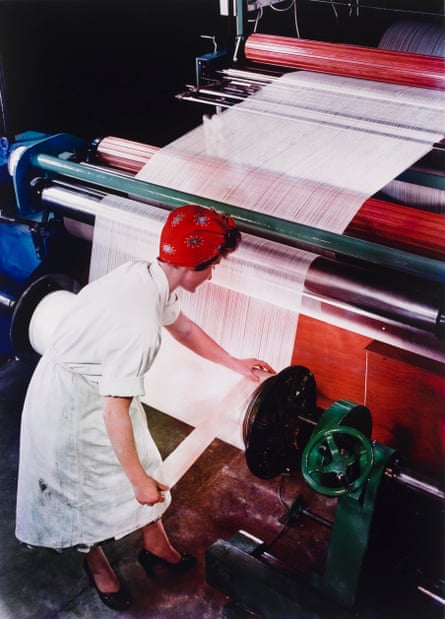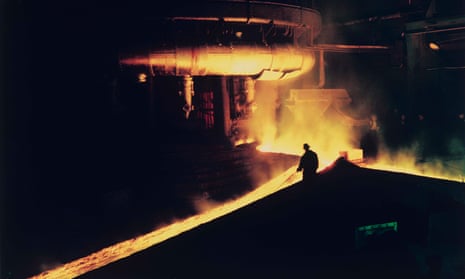Ian Cowmeadow has a degree in photography and an MA in creative nonfiction writing from City University, London. He writes fiction and nonfiction and lives in Hackney, east London.
The man with the goggles and the Covid-style face mask is photographed from a low angle, giving him a towering presence in the frame. It’s a meticulously constructed image, with strong diagonals formed by the man’s outstretched arm and the lever his hand is gripping. The lighting is minimal but precise. This is a fettler at work in Ford’s Dagenham plant in 1953.
In the context of Maurice Broomfield’s photographs of British industry, which are currently showing at the Photography Centre at the V&A, there’s something about the fettler. Broomfield was not a documentary photographer and his images are as planned and fabricated as anything that rolled out of the factory gates he frequented. Far from using a concealed camera, as Lewis Hine did in the early 20th century to expose conditions in American factories, Broomfield was always laden with equipment. Large-format plate cameras, tungsten lighting on stands and an array of gobos and reflectors meant everyone knew when he was around. Even the more agile Mamiyaflex that he hung round his neck was built like a tank.

It was an approach he felt would best meet one of his stated aims – to portray the workers in Britain’s postwar industry with the dignity he believed they deserved. He himself had started life on the production line of the Rolls-Royce factory in Derby. Although it was a path he never wanted to follow, he retained a deep respect for those communities that found their purpose in the workshops and mills of their local manufacturer.
His other motive was essentially propagandistic. In the decades after the war, much of the UK’s industry was making do and mending, using repurposed sheds or yards and replicating the sophisticated equipment used in more modern factories with improvised get-arounds – wheeling parts across a shop floor in trolleys, for example, to do the work a conveyor system would do more efficiently. Broomfield felt he could help to attract investors by presenting dynamic, glorified images of the new Britain at work.
So it is no surprise that there is something of the Soviet poster about some of these photographs; a flat-capped worker dwarfed by the ship’s propeller he is balancing in Glasgow, a head-scarfed woman trapped in the composition of rigid lines made by the warp thread she is adjusting at a mill in Belper. It’s a feel in the images that comes, too, from Broomfield’s influences; from the drama of Joseph Wright of Derby to that other great photographer of industry, Walter Nurnberg, by way of Albert Renger-Patzsch and the constructivists.

The photographs here are controlled, staged and almost sanitised. When Broomfield said that “the visual interpretation of industry can be as glamorous as fashion photography” he knew what he was talking about. Before embarking on the work by which he is best known, he was partner in the society portrait studio of Madame Yevonde in Berkeley Square. For a brief period there he “dabbled” in fashion work but, even without that, it was a place where life was staged and constructed for the camera. Approaching the giant, theatrical spaces where industry lurked, almost his first instinct was to tame the scene. If he wasn’t clearing a floor to place his lights or painting people’s boots white in a milk-bottling plant, he was persuading workers to come in at night so he could nail the look he wanted.
These photographs took time to create. Factory work stopped so that Broomfield’s work could take place. For the photograph of the fettler, he recalls that it didn’t take quite as long as some of his other images because he dispensed with his usual method of making a preliminary sketch. Even so, his subject was not best pleased. Given that the fettler’s job is to file away the rough edges and loose matter from freshly cast components, it might be thought that he would sympathise with a man taking his time to ensure that all unnecessary detail was cleared out of the way before he made his exposure. But the fettler was on piece work – lost minutes meant lost pay.
Of all the people in these images, the fettler is the one who is most present. In among the dramatic lighting, giddying contrasts of scale and a cast of dedicated operatives driving industry ever onward, he alone confronts the camera. It’s almost a breaking of the photographer’s fourth wall. Hearing Broomfield talk about this picture, as you can in the extract from his son’s documentary film that is playing in the gallery, it is clear that he was very proud of it. Because for all the glossy brochures and financial pages where his pictures regularly appeared in print, these people are what Broomfield’s work was really about.
